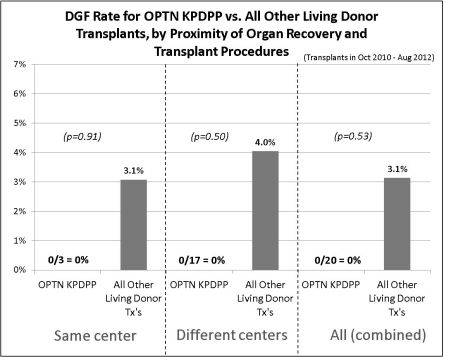Early Look at Transplant Outcomes from the OPTN KPD Pilot Program: Comparing Cold Times and DGF Rates with Other Living and Deceased Donor Transplants, An
UNOS
Yale Medical Ctr
Univ of Florida
Northwestern Univ
Carnegie Mellon Univ
Meeting: 2013 American Transplant Congress
Abstract number: 338
Purpose: In Dec 2010, the Organ Procurement and Transplantation Network Kidney Paired Donation Pilot Program (OPTN KPDPP) facilitated the first of 27 (through Nov 2012) transplants. This report reviews the cold ischemic times (CIT) and rates of delayed graft function (DGF) of kidneys transplanted in the program compared with all other living and deceased donor kidney transplants.
Methods: OPTN data on transplants occurring between Oct 2010 and Aug 2012 were evaluated for CIT and recipient DGF (need for dialysis within 1 week of transplant). The distribution of CIT and the proportion of transplants resulting in DGF were compared among OPTN KPDPP, all other living donor (including other KPD), and deceased donor transplants.
Results: For OPTN KPDPP transplants that occurred at a center different from the donor nephrectomy center, the median CIT was 8 hours (max of 12.8), compared with 4 hours for all other, "different center" living donor transplants. Among "nationally matched" (outside of DSA and Region) living donor transplants, median CIT for the OPTN KPDPP (8.8 hrs) was comparable to median CIT for all other living donor transplants (9.0). The DGF rate was 0% for the 20 OPTN KPDPP transplants with complete data available, and 3.1% for all other living donor transplants (p=0.53). The DGF rate was 3.1% for all other "same center" living donor kidney transplants, compared to 4.0% for "different center" living donor transplants.

Conclusion: Since most "different center" OPTN KPDPP transplants were outside of DSA and Regional boundaries, it was expected that median CIT was higher for the OPTN KPDPP vs. other living donor transplants. Among "nationally matched" living donor transplants, median CIT was nearly identical for the OPTN program and other living donor transplants. However, there have been no cases of DGF in the pilot program thus far, suggesting that transporting kidneys up to 12+ hours in a national KPD program does not significantly affect the likelihood of DGF.
To cite this abstract in AMA style:
Leishman R, Formica R, Andreoni K, Friedewald J, Sleeman E, Monstello C, Stewart D, Sandholm T. Early Look at Transplant Outcomes from the OPTN KPD Pilot Program: Comparing Cold Times and DGF Rates with Other Living and Deceased Donor Transplants, An [abstract]. Am J Transplant. 2013; 13 (suppl 5). https://atcmeetingabstracts.com/abstract/early-look-at-transplant-outcomes-from-the-optn-kpd-pilot-program-comparing-cold-times-and-dgf-rates-with-other-living-and-deceased-donor-transplants-an/. Accessed December 14, 2025.« Back to 2013 American Transplant Congress
